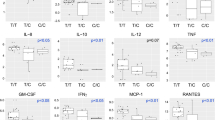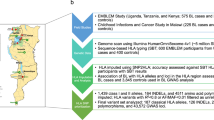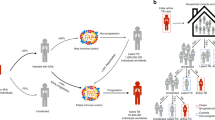Abstract
CD1 proteins are antigen-presenting molecules that evolved to present lipids rather than peptides to T cells. However, unlike major histocompatibility complex genes, CD1 genes show low rates of polymorphism and have not been clearly associated with human disease. We report that an intronic polymorphism in CD1A (rs411089) is associated with susceptibility to tuberculosis in two cohorts of Vietnamese adults (combined cohort odds ratio 1.78; 95% confidence interval: 1.24–2.57; P=0.001). These data strengthen the hypothesis that CD1A-mediated lipid antigen presentation is important for controlling tuberculosis in humans.
This is a preview of subscription content, access via your institution
Access options
Subscribe to this journal
Receive 6 digital issues and online access to articles
$119.00 per year
only $19.83 per issue
Buy this article
- Purchase on Springer Link
- Instant access to full article PDF
Prices may be subject to local taxes which are calculated during checkout

Similar content being viewed by others
References
Russell DG, Barry CE 3rd, Flynn JL . Tuberculosis: what we don't know can, and does, hurt us. Science 2010; 328: 852–856.
Zumla A, Raviglione M, Hafner R, von Reyn CF . Tuberculosis. New Engl J Med 2013; 368: 745–755.
Remus N, Alcais A, Abel L . Human genetics of common mycobacterial infections. Immunol Res 2003; 28: 109–129.
Casanova JL, Abel L . Genetic dissection of immunity to mycobacteria: the human model. Annu Rev Immunol 2002; 20: 581–620.
Beckman EM, Porcelli SA, Morita CT, Behar SM, Furlong ST, Brenner MB . Recognition of a lipid antigen by CD1-restricted alpha beta+ T cells. Nature 1994; 372: 691–694.
Montamat-Sicotte DJ, Millington KA, Willcox CR, Hingley-Wilson S, Hackforth S, Innes J et al. A mycolic acid-specific CD1-restricted T cell population contributes to acute and memory immune responses in human tuberculosis infection. J Clin Invest 2011; 121: 2493–2503.
Van Rhijn I, Ly D, Moody DB . CD1a CD1b, and CD1c in immunity against mycobacteria. Adv Exp Med Biol 2013; 783: 181–197.
Dascher CC . Evolutionary biology of CD1. Curr Top Microbiol Immunol 2007; 314: 3–26.
Balk SP, Bleicher PA, Terhorst C . Isolation and expression of cDNA encoding the murine homologues of CD1. J Immunol 1991; 146: 768–774.
Moody DB, Young DC, Cheng TY, Rosat JP, Roura-Mir C, O'Connor PB et al. T cell activation by lipopeptide antigens. Science 2004; 303: 527–531.
Rosat JP, Grant EP, Beckman EM, Dascher CC, Sieling PA, Frederique D et al. CD1-restricted microbial lipid antigen-specific recognition found in the CD8+ alpha beta T cell pool. J Immunol 1999; 162: 366–371.
Seshadri C, Shenoy M, Wells RD, Hensley-McBain T, Andersen-Nissen E, McElrath MJ et al. Human CD1a deficiency is common and genetically regulated. J Immunol 2013; 191: 1586–1593.
Horne DJ, Randhawa AK, Chau TT, Bang ND, Yen NT, Farrar JJ et al. Common polymorphisms in the PKP3-SIGIRR-TMEM16J gene region are associated with susceptibility to tuberculosis. J Infect Dis 2012; 205: 586–594.
Khor CC, Chau TN, Pang J, Davila S, Long HT, Ong RT et al. Genome-wide association study identifies susceptibility loci for dengue shock syndrome at MICB and PLCE1. Nat Genet 2011; 43: 1139–1141.
Shephard N . GENASS: Stata Module to Perform Genetic Case-Control Association Tests. Department of Economics, Boston College: Boston, MA, USA, 2005.
Acknowledgements
We acknowledge the work of the clinical staff from the Hospital of Tropical Diseases and Pham Ngoc Thach Hospital who initially diagnosed and studied the patients with TBM and PTB. We thank Dr Nguyen Thi Hieu from the Hung Vuong Obstetric Hospital, Vietnam, Dr Tran Tinh Hien from the Hospital for Tropical Diseases, Vietnam and all the Vietnamese doctors and patients who participated in this study. We thank Dr Alan Aderem (Seattle BioMed), Dr Marta Janer and Dr Sarah Li (Institute for Systems Biology) for advice and technical assistance. This study was funded in part by the NIH (K24AI089794 to TRH and K08AI089938 to CS), the Burroughs Wellcome Foundation (TRH) and the Irvington Institute Fellowship Program (CS). The clinical component of this study was funded through the Wellcome Trust Major Overseas Program in Vietnam (089276/Z/09/Z).
Author information
Authors and Affiliations
Corresponding author
Ethics declarations
Competing interests
The authors declare no conflict of interest.
Additional information
The findings described here are unpublished but were presented as an oral abstract at the Sixth International Symposium on CD1 and NKT Cells (Chicago, IL, USA, 23–27 September 2011) and as a poster at the Host Response in Tuberculosis Keystone Symposium (Whistler, CA, USA, 13–18 March 2013).
Supplementary Information accompanies this paper on Genes and Immunity website
Supplementary information
Rights and permissions
About this article
Cite this article
Seshadri, C., Thuong, N., Yen, N. et al. A polymorphism in human CD1A is associated with susceptibility to tuberculosis. Genes Immun 15, 195–198 (2014). https://doi.org/10.1038/gene.2014.5
Received:
Revised:
Accepted:
Published:
Issue Date:
DOI: https://doi.org/10.1038/gene.2014.5
Keywords
This article is cited by
-
Clinical manifestations and immune response to tuberculosis
World Journal of Microbiology and Biotechnology (2023)
-
CD1a promotes systemic manifestations of skin inflammation
Nature Communications (2022)
-
Immunological mechanisms of human resistance to persistent Mycobacterium tuberculosis infection
Nature Reviews Immunology (2018)
-
Donor-unrestricted T cells in the human CD1 system
Immunogenetics (2016)
-
CD8 T cells and Mycobacterium tuberculosis infection
Seminars in Immunopathology (2015)



